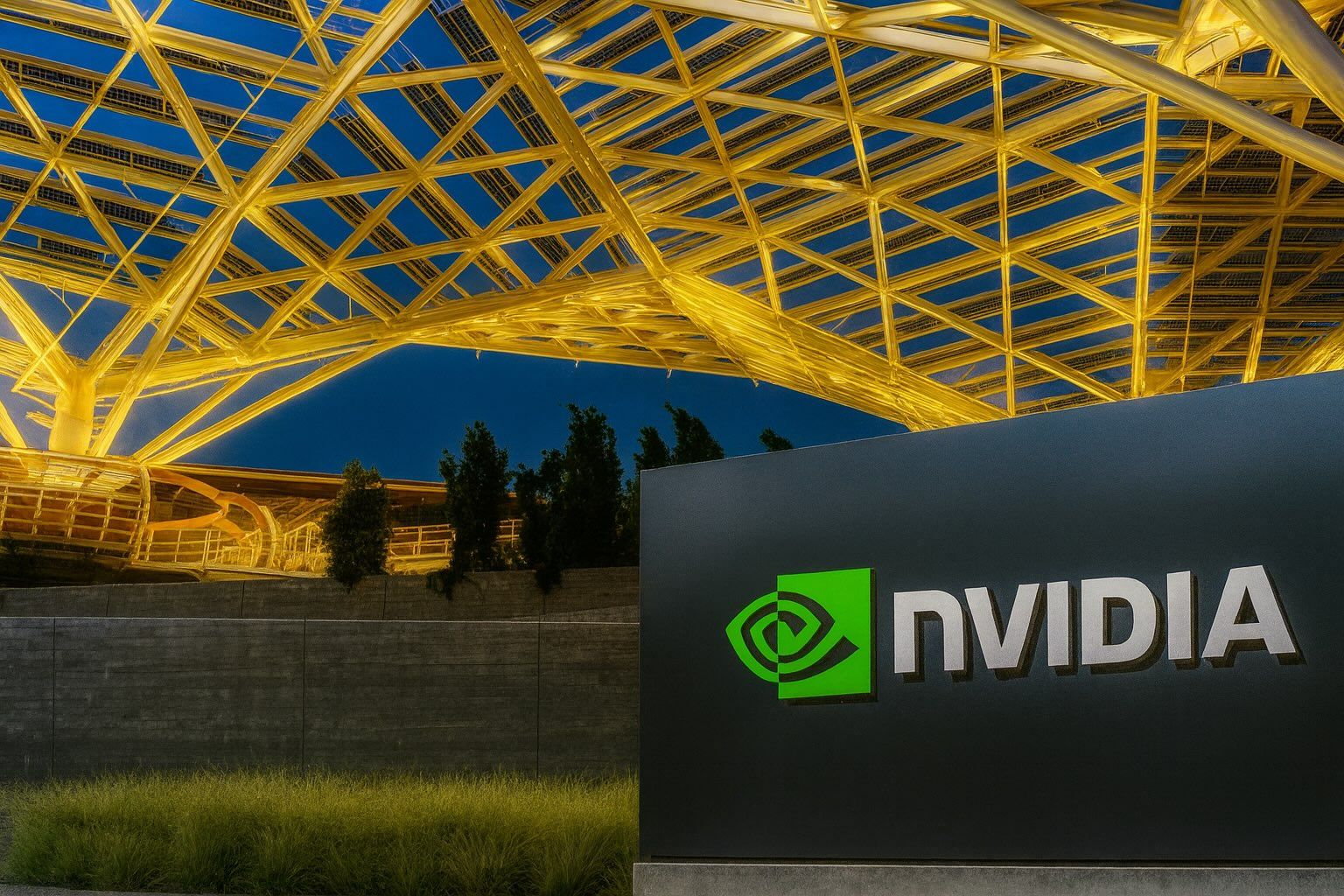- Nvidia stock near $182 after volatile week: NVDA sits around $181–$182 per share as of October 17, 2025 [1]. The stock hit record highs near $195 in early October [2] before pulling back on profit-taking and market jitters.
- AI frenzy fuels massive growth: Explosive demand for Nvidia’s AI chips drove a 56% revenue surge last quarter to $46.7 billion [3]. Data-center sales alone hit an unprecedented $41 billion [4], propelling Nvidia’s market value above $4.4 trillion [5] – briefly the world’s largest company.
- New challenges emerge:Competition is heating up – AMD’s latest wins (including a big OpenAI chip deal and Oracle’s adoption of AMD AI chips) have stirred concern [6] [7]. Meanwhile, U.S.–China trade tensions and export curbs on advanced chips are creating uncertainty for Nvidia, which earns an estimated 10–15% of revenue from China [8].
- Analysts mostly bullish, eyes on earnings: Wall Street remains upbeat despite high valuations. 38 of 47 analysts rate NVDA a “Buy,” with average price targets around $210–$220 (≈15% above current levels) [9]. Nvidia reports earnings on Nov. 19, and another blockbuster quarter is anticipated [10]. Investors are watching if AI demand can keep defying expectations.
NVDA Stock Rollercoaster: From Record Highs to Sharp Swings
Nvidia’s stock has been on a wild ride in recent days. The share price reached an all-time high of about $195.62 in early October [11] amid frenzied buying, but then rapidly reversed course. By Tuesday, Oct. 14, NVDA had tumbled over 4% in a single session to around $180 [12] as traders cashed in gains and broader tech stocks slipped. The Nasdaq’s tech sector was down that day, reflecting profit-taking and a rotation out of high-flying names. Even so, Nvidia’s stock remains near its peaks – still roughly 58% higher than a year ago [13] and up astronomically over the past decade – underscoring its status as the market’s premier “AI play.” By the close on Oct. 16, NVDA had ticked back up to $181.81 [14], showing resilience after the mid-week dip.
Market context: Part of the recent volatility is driven by macro trends. In early October, excitement around artificial intelligence reignited a rally that added over $200 billion to semiconductor stocks within days [15]. But by mid-October, rising bond yields and strong bank earnings triggered a shift – investors rotated out of expensive tech shares into other sectors [16]. High-valuation stocks like Nvidia (trading around 50× earnings [17], well above market norms) proved especially sensitive to these sentiment swings. Short-term traders have been quick to “buy the dip” on Nvidia and just as quick to take profits, contributing to the seesaw action [18]. Still, Nvidia’s central role in the AI story means demand for its stock remains intense, keeping it squarely in the market spotlight through every twist.
AI Boom Drives Record Sales and a $4.5 Trillion Valuation
Nvidia’s fundamentals are living up to the hype of its stock. The company is shattering earnings records thanks to an unprecedented AI computing boom. In its fiscal Q2 2026 (May–July 2025), Nvidia’s revenue rocketed 56% year-over-year to $46.7 billion [19], blowing past expectations. Remarkably, around 88% of those sales ($41.1 billion) came from data-center products – mainly the GPUs that power generative AI models [20]. This marks one of the fastest growth spurts ever seen for a company of Nvidia’s size. Profitability has followed suit: gross margins run above 72%, and net profit margins top 50% [21], reflecting extraordinary economies of scale as AI chip orders flood in.
Investors have rewarded Nvidia’s torrid growth by bidding up its market capitalization to towering heights. In early October, Nvidia’s market cap briefly surpassed $4.5 trillion [22] – overtaking every other company on the planet. At roughly $4.4 trillion today, Nvidia is worth more than 10× its rival AMD (≈$350 billion) and about 30× Intel (~$150 billion) [23]. This leap has made Nvidia a bellwether not just for tech, but for the entire stock market’s mood. The company’s valuation has expanded to roughly 53× trailing earnings (about 33× forward) [24], a multiple far above the semiconductor industry average, which has inevitably sparked debate over how much of the “AI hype” is already priced in.
Key drivers: Nvidia’s ascent is underpinned by more than just headlines – it reflects real developments in the business. The company continues to roll out new products and partnerships at a breakneck pace, reinforcing its leadership in AI. For example, Nvidia recently launched its GeForce RTX 50-series graphics chips with AI-boosted graphics and started shipping DGX Spark, billed as the world’s smallest AI supercomputer [25]. The firm has also unveiled a bold vision for next-generation “AI factories” – essentially massive data centers with cutting-edge 800-volt power infrastructure to support future AI models [26]. (In fact, one smaller supplier, Navitas, saw its stock jump 27% after Nvidia chose its chips for these 800V systems [27], underscoring Nvidia’s wider influence in tech ecosystems.)
At the same time, Nvidia is locking in mega-deals that secure demand for years to come. In September, the company signed a landmark partnership with OpenAI, the maker of ChatGPT. Nvidia agreed to supply 10 gigawatts of GPU computing capacity to OpenAI and even plans to invest up to $100 billion in OpenAI’s next-gen models as those data centers are built [28] [29]. This unprecedented arrangement blurs the line between vendor and investor – Nvidia is essentially funding one of its largest customers so that it can buy even more Nvidia hardware. The company is also collaborating with major cloud players: it announced a surprise $5 billion equity stake in Intel to co-develop advanced chips (an unusual alliance between rivals) [30], and it’s reportedly working with firms like Microsoft and Amazon to deploy massive AI infrastructure. In the U.K., Nvidia is helping build national AI supercomputers (“AI factories”) involving tens of thousands of Nvidia GPUs and billions in investment [31]. These moves point to an overarching strategy – Nvidia isn’t resting on its laurels, but aggressively entrenching itself at the heart of the AI economy.
Rising Competition and Geopolitical Clouds
Even as Nvidia rides the AI wave, competitive and geopolitical storms are gathering on the horizon. Perhaps the biggest challenger is AMD, which has begun scoring headline-grabbing wins in the AI chip arena. Earlier this month, AMD stunned the market with a multi-year deal to supply 6 GW of AI GPU capacity to OpenAI [32] – a direct challenge to Nvidia’s dominance at that key customer. The partnership even gives OpenAI an option to take up to a 10% ownership stake in AMD as part of the bargain [33], signaling how strategic these chip alliances have become. Wall Street immediately recognized the significance: AMD’s stock soared 34% in a single day on the news, its biggest jump in 9 years [34], adding about $80 billion to AMD’s market value overnight. Industry observers called the deal “transformative, not just for AMD, but for the industry”, even as they noted it’s “unlikely to dent Nvidia’s dominance” in the near term [35]. One strategist argued the AMD win “helps validate [AMD’s] technology” yet doesn’t change the fact that Nvidia still sells every AI chip it can make – underscoring that demand far outstrips any single supplier’s capacity [36]. Tellingly, Nvidia’s share price barely blinked at AMD’s coup, dipping only ~1% on the announcement [37]. That muted reaction implies investors see the AI market as large enough for multiple winners, with Nvidia firmly in the driver’s seat for now.
AMD isn’t the only rival making moves. This week, Oracle announced a partnership with AMD to incorporate 50,000 of AMD’s upcoming MI450 AI chips into Oracle’s cloud infrastructure by 2026 [38]. The deal gives AMD another high-profile customer for its next-gen accelerators – a sign that big cloud buyers are actively diversifying their AI hardware suppliers beyond Nvidia. Meanwhile, Broadcom has also entered the fray: the chipmaker revealed a tie-up with OpenAI to provide 10 GW of AI accelerator capacity built on Broadcom technology [39], effectively mirroring Nvidia’s own OpenAI deal. News that Broadcom, Nvidia and AMD are all engaged with OpenAI added to investor jitters about a coming “chip war” for AI dominance [40]. However, some experts caution that this isn’t necessarily a zero-sum game. “If you don’t have the compute, you don’t have a chance. To that end, Broadcom, Nvidia and AMD can all win,” wrote Melius Research analyst Ben Reitzes, suggesting the AI pie is expanding so rapidly that multiple chip makers will thrive [41]. In other words, demand for AI horsepower is so insatiable right now that Nvidia’s growth can coexist with rising competition, at least in the near term.
On another front, geopolitical tensions are injecting uncertainty into Nvidia’s outlook. The U.S.–China tech rivalry has increasingly centered on advanced chips – and Nvidia finds itself caught in the crossfire. Roughly a tenth of Nvidia’s revenue comes from China [42], including sales of specialized AI GPUs that Washington has tried to restrict. Over the past year, U.S. authorities imposed export controls to bar cutting-edge Nvidia processors from China, aiming to limit Beijing’s AI capabilities. Nvidia responded by creating slightly neutered China-specific chips (like the “RTX 6000D”), but Chinese regulators have pushed back too. Just last week, reports emerged that China is tightening customs checks on Nvidia’s AI chip shipments at its ports [43], enforcing its own import restrictions in an effort to boost home-grown semiconductors. And in September, China’s government even ordered tech firms to halt purchases of Nvidia AI chips and cancel orders – accusing Nvidia of monopolistic practices [44]. All this comes as political rhetoric escalates: U.S. officials have floated both stricter bans and, at times, hints of easing rules for Nvidia depending on broader trade negotiations [45].
These developments came to a head in markets on Oct. 14, when trade fears helped knock Nvidia’s stock down 4% in one day [46]. Traders were spooked by reports that Beijing was scrutinizing U.S. companies and by speculation that Washington might announce new export curbs on AI chips – a one-two punch that could stifle Nvidia’s future sales in China [47]. Chipmakers across the board fell on those headlines. The episode highlighted Nvidia’s delicate position: as the global AI leader, it stands to gain from nearly every major AI investment, but it’s also especially vulnerable to geo-strategic policy shifts. Any move by Washington or Beijing can ricochet through Nvidia’s share price. For now, the company has navigated restrictions by selling modified chips in China (and lobbying against overly harsh rules). But uncertainty remains high – a wildcard risk that investors are closely monitoring alongside the company’s competitive battles.
Wall Street Outlook: Bullish Sentiment (With a Side of Caution)
Despite these challenges, the prevailing mood among analysts and investors toward Nvidia remains optimistic. Wall Street’s top experts largely believe the AI juggernaut still has room to run. According to a recent survey, 38 out of 47 analysts covering NVDA rate the stock a “Buy” or equivalent [48]. Price targets continue to ratchet higher: the 12-month consensus target is around $210–$220 per share [49], roughly 15–20% above the current price. Many firms have upgraded their forecasts following Nvidia’s latest results. For instance, Jefferies recently lifted its NVDA target to $220, and Loop Capital went even further – all the way to $250 – citing Nvidia’s unparalleled position to ride the “golden wave” of AI demand [50]. “Our work suggests we are entering the next ‘Golden Wave’ of Gen AI adoption and NVDA is at the front-end of another material leg of stronger than anticipated demand,” Loop Capital’s analyst Ananda Baruah wrote in a note when raising his target [51]. That enthusiasm reflects a widespread view that Nvidia will continue delivering growth at a pace rare for a company of its size.
Investors are also eagerly anticipating Nvidia’s next earnings report, due on November 19, 2025 [52]. The upcoming fiscal Q3 results (for the quarter ending in October) are expected to show another stunning performance. Nvidia’s management already guided for roughly 54% year-over-year revenue growth in Q3 [53] – an almost unheard-of rate for a $4 trillion company – and that forecast notably excludes any potential sales to China, given the export uncertainties [54] [55]. If history is any guide, Nvidia has a habit of handily beating its guidance. In the previous quarter, the stock actually barely moved on the earnings release – not because the numbers disappointed (they were record-breaking), but because traders had bid the stock up nearly 20% in the weeks before the report on expectations of a huge beat [56]. A similar dynamic could play out again: as the Nov. 19 date nears, we may see investors piling into NVDA in hopes of another upside surprise [57]. In the short term, that anticipation alone can lift the stock.
That said, a note of caution is beginning to creep in at these lofty levels. A few analysts have recently urged clients not to get carried away. They point out that Nvidia’s valuation – at over 50× earnings and nearly 20× sales – leaves little margin for error [58]. Any hint of a slowdown in the AI frenzy or a supply hiccup could spark a sharp correction. Even bullish analysts acknowledge the stock’s momentum has been “priced to perfection” after a roughly 1,500% rise in just three years (a staggering run that has prompted talk of an “AI bubble” in some quarters). For now, those warnings remain minority opinions against the overwhelmingly positive sentiment in the market. Investor appetite for Nvidia is still strong, and dips tend to be viewed as buying opportunities – as evidenced by how quickly the stock rebounded from each pullback this year [59].
The road ahead: Ultimately, Nvidia’s fortunes will hinge on its ability to maintain its breakneck growth and fend off rivals in a rapidly expanding arena. In the coming weeks, all eyes will be on the Nov. 19 earnings release to confirm that the AI boom is still in full swing. If Nvidia once again delivers results that trounce forecasts, it could rekindle another rally into year-end. Longer term, the company’s leadership in AI hardware and software ecosystems gives it a formidable moat, but it will need to continuously innovate to stay ahead of hungry competitors. For investors and the general public alike, Nvidia has become the de facto barometer of the AI revolution – its stock chart reflecting both the promise and the volatility that come with betting on world-changing technology. As one analyst put it, this is not just a story stock – its revenues and cash flows are very real [60]. And for now, those numbers are hard to argue with. Barring any big surprises from Washington or a new challenger, the consensus is that Nvidia’s AI-fueled growth story still has chapters to go [61]. In the words of a recent investment note: “Don’t sleep on Nvidia” [62] – the company is at the heart of a once-in-a-generation tech boom, and the world is watching closely to see what it does next.
Sources: Nvidia investor data, TS2.Tech analysis, Reuters, Motley Fool, Yahoo Finance [63] [64] [65] [66]. (All data current as of Oct. 17, 2025)
References
1. www.investing.com, 2. ts2.tech, 3. ts2.tech, 4. ts2.tech, 5. ts2.tech, 6. ts2.tech, 7. www.reuters.com, 8. ts2.tech, 9. ts2.tech, 10. www.nasdaq.com, 11. ts2.tech, 12. ts2.tech, 13. ts2.tech, 14. www.investing.com, 15. ts2.tech, 16. ts2.tech, 17. ts2.tech, 18. ts2.tech, 19. ts2.tech, 20. ts2.tech, 21. ts2.tech, 22. ts2.tech, 23. ts2.tech, 24. ts2.tech, 25. ts2.tech, 26. ts2.tech, 27. ts2.tech, 28. www.reuters.com, 29. www.reuters.com, 30. ts2.tech, 31. ts2.tech, 32. ts2.tech, 33. ts2.tech, 34. ts2.tech, 35. ts2.tech, 36. ts2.tech, 37. ts2.tech, 38. www.reuters.com, 39. ts2.tech, 40. ts2.tech, 41. ts2.tech, 42. ts2.tech, 43. www.reuters.com, 44. www.reuters.com, 45. www.reuters.com, 46. ts2.tech, 47. ts2.tech, 48. ts2.tech, 49. ts2.tech, 50. ts2.tech, 51. www.reuters.com, 52. www.nasdaq.com, 53. www.nasdaq.com, 54. www.nasdaq.com, 55. www.nasdaq.com, 56. www.nasdaq.com, 57. www.nasdaq.com, 58. ts2.tech, 59. ts2.tech, 60. www.nasdaq.com, 61. ts2.tech, 62. www.nasdaq.com, 63. ts2.tech, 64. ts2.tech, 65. www.reuters.com, 66. www.nasdaq.com







